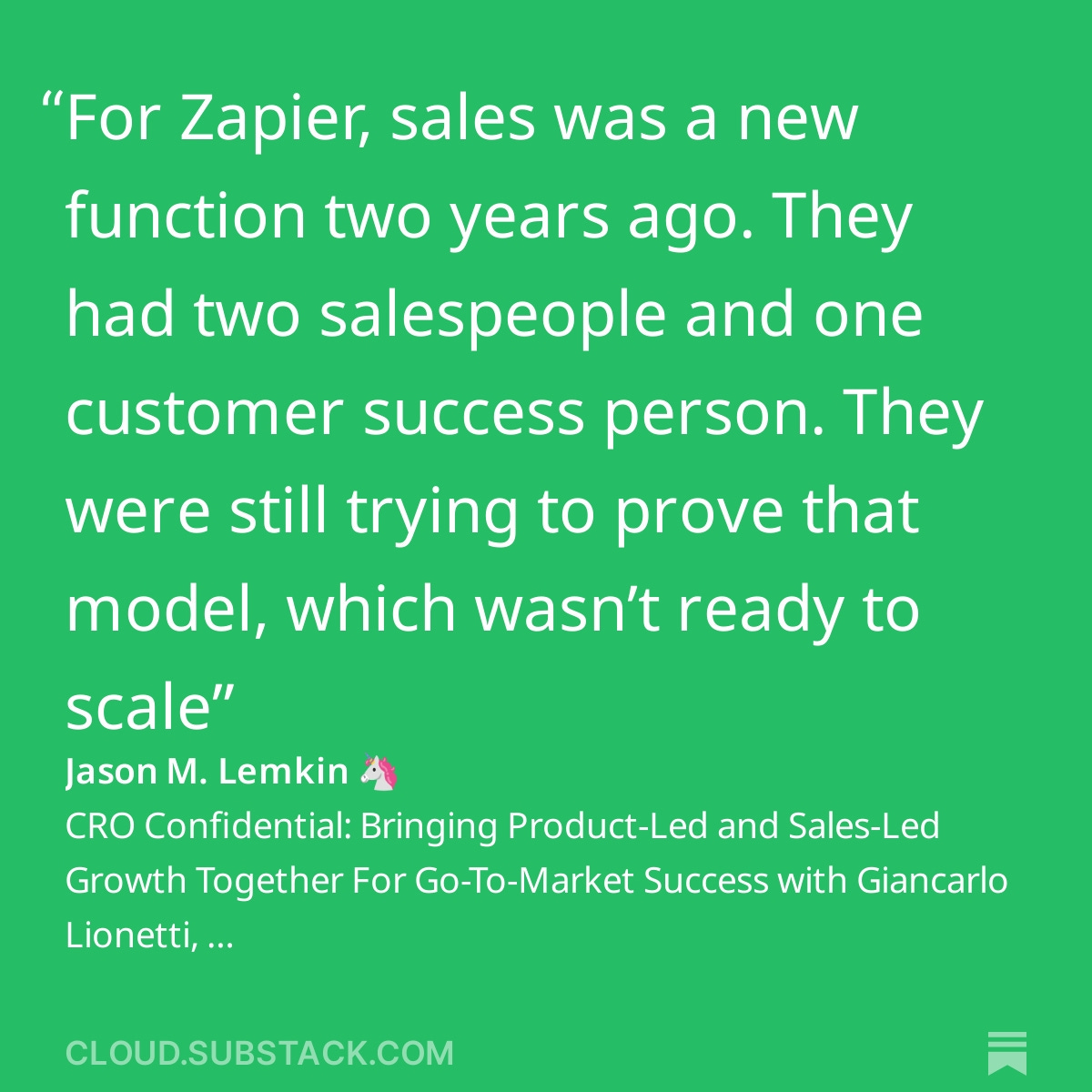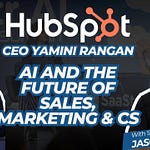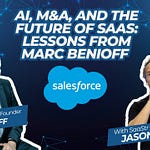In this latest episode of CRO Confidential, Sam Blond, Partner at Founders Fund and former CRO at Brex, sits down with the CRO of Zapier, Giancarlo Lionetti (GC), to chat about Product-Led Growth (PLG) and Go-To-Market (GTM). Everything from hiring on the GTM side to layering in a sales-led motion into PLG.
Before joining Zapier, Giancarlo was at Atlassian as a technical sales lead before moving to DropBox as a Senior Director of Growth and Monetization, and was CMO at Confluent – so he has a wealth of knowledge from Zapier’s Go-To-Market history as well as these successful SaaS companies to pull from. While we use Zapier here at SaaStr and are super familiar with it, for those who don’t use the tool, it’s a workflow automation platform that connects your data sources and apps to help maximize the efficiency of your teams, tools, and processes without relying on a developer team.
From a Go-To-Market perspective, Zapier uses a hybrid model that involves a combination of freemium offerings, subscription plans, and partnerships. Let’s dive into what’s making that hybrid model successful:
PLG and Sales Led? At the same time?
We’re in an era defined by interconnectivity and digital transformation, and Product-Led Growth (PLG) has become an increasingly pivotal approach for achieving scalable company success. In a product-led growth strategy, the product serves as the focal point of your company’s marketing and strategies. It is often the first point of interaction between potential customers and your company. Given this, you must understand the role that each facet of the business plays in promoting that product, from marketing and sales to customer service.
First, we’ve talked about this a lot at SaaStr: product-led or sales-led, which is right? Some say sales if you don’t have a product that lends itself to being self-service. Others say PLG because it provides you a more natural path to up-sell and expand from people who are already interested and familiar with your product. Zapier says for them, the right answer is actually a mix of both. ZoomInfo also says both, and so does Grammarly, for what it’s worth.
Either way, the foundation for success in Go-To-Market starts with the right team. GC thinks about building out your Go-To-Market team in 3 ways:
Short vs. long-term needs
Product maturity
Experimental vs. scale
Short-term vs. long-term needs. Often, when debating a role, especially on the GTM side, you’re balancing short and long-term needs. For example, a key goal of the company might be to drive top-line growth by 20% percent. The first role that comes to mind is driving revenue and it’s probably within sales. So, you might hire someone for inbound or outbound sales to meet that growth. That’s a potential short-term way of thinking. A long-term way of thinking would be hiring on the demand gen side since you might not hit that top-line growth unless you create demand coming in.
Product Maturity. Next, think about product maturity. When Giancarlo started at Zapier, its product maturity at the time on the upmarket side was still new for them. They had been building toward an SMB audience, so hiring 50 people in sales against a product that wasn’t ready for a specific audience would’ve been a mistake. You have to think about where your product maturity is before making the hire.
Experimental vs. Scale. The last thing to consider when hiring on the GTM side is whether the role is more experimental or intended to help you scale. In a startup, you might have a strong hypothesis, but it might not work out. For Zapier, sales was a new function two years ago. They had two salespeople and one customer success person. They were still trying to prove that model, which wasn’t ready to scale. So, they were hiring a more experimental role vs. one ready to scale.
New hires in your GTM team will usually fall within one of four categories:
Distribution
Revenue
Storytelling or messaging
Some form of operations
Most of the time, it’s distribution or revenue, qualify people as in or out for those two areas. You have to figure out how to prioritize against these categories and use the three areas above to help scale your go-to-market team.
Going-To-Market With Budget Constraints
Giancarlo joined Zapier as CRO when it was a more mature business, and admittedly, later than many hire their first CRO. So when’s the right time to invest more in sales and marketing when we’re all trying to become radically efficient?
GC says we’re universally underinvesting in sales and marketing for a few reasons:
Your heads down focused on the product. At some point, you need to get that product out to the world, drive some level of demand, and close that demand into dollars.
You’re not clear on the actual needs your business has. There’s no silver bullet. When under-resourced, you try to find a temporary solution that causes a mismatch.
Instead, hire based on an understanding of what the business needs and where the bottlenecks and constraints exist. Oftentimes, there is over-resourcing in the middle of the funnel with closing customers and under-resourcing at the top of the funnel and generating demand.
Another place that’s often misdiagnosed or under-resourced is post-sales. There are usually too many CSMs and not enough implementation hires. The initial experience a customer has with a product or company has so much influence on the lifetime value of that customer. People often lump all customers into one category post-sales rather than segmenting them based on where they are in their experience with your product.
Subscribed
How to Create a Successful PLG Motion
Zapier and Atlassian are famous for scaling product-led growth. How does GC define PLG? Simply put the product does the selling. So when you think about acquisition, retention, and expansion, they all revolve around the product capabilities in a PLG motion. PLG flips the traditional sales model and is less about the executive buyer and more about the end user. The product becomes your sales team.
What are the most important things about this acquisition strategy that make it successful?
Product
Audience
Team and Organization Setup
Product. It has to be easy to try and buy. Users need to be able to experience the entire product, not a diluted version, before paying for it. You also want to be very user-centric, with simplicity, intuitive interfaces, and addressing user pain points directly within the product.
Audience. Ensure the audience prefers trying and buying before setting up a PLG motion. Self-serve worked for Atlassian because, early on, the audience was primarily developers who didn’t want to talk to salespeople.
Team and organization setup. For PLG, you have to pay attention to the front and back end. The front end is executing the key tactics for growth, like your website, product onboarding, and human interactions (when the user wants/ needs it). The back end is often underestimated, and it focuses on data, systems, and tools to support the motion.
For PLG, the experience with the customer starts as soon as the user comes into the product. You’re logging every data point from the top of the funnel throughout your product — activation rates, product usage, and key conversion rates across the funnel. There’s a lot more data and users to keep track of than when you’re using just a sales-led model, and because you don’t have a salesperson involved, no one is catching the user if they’re stuck or about to churn out. Zapier uses this data to segment and qualifies users based on product usage to either empower their success or now, pass them onto sales if there’s an expansion opportunity.
The Role of Sales in PLG
Plugging sales into a PLG approach might seem like a square peg in a round hole given that PLG focuses on the product rather than a sales team. However, used at the right time a sales team can provide significant value in a PLG strategy. In a product-led growth approach, more emphasis is given to the end user rather than executives who might traditionally be targeted in a sales-led motion. However, sales can complement this, as they do at Zapier, by acting as a link between the product and its users.
This human engagement is important in dealing with the complexities of the customer journey, particularly where there is a high level of complexity or a specific problem to be solved and with high-value stakeholders. In other words, they bridge the gap between the automation of the PLG approach and the human touch and can step in once the data shows their customer has high production usage and is potentially ready for an expansion.
Two pitfalls GC has seen when moving to a combination of product-led and sales-led:
#1 Keep in mind that PLG is a volume game. The whole point is to be very ROI-friendly and very budget-efficient. The moment you add a human on the sales team to that loop, it automatically brings down the ROI. While sales can help you zero in on more specific, larger deals or target a certain ICP, PLG by nature is a much broader swath of customers. But remember, the ROI should still be much better in pure PLG than sales-led. If it’s not, then it’s probably not working or your product is too complex to be self-serviced.
#2 Remember that the tactics and channels for product-led vs sales-led are actually .. the same. Now how you leverage those channels will be dramatically different but they are the same to start. As an example, for GC at Atlassian’s product-led growth, they leaned heavily into content and SEO in a very aggressive way. Whereas at Confluent, a sales-led growth model, they didn’t rely on content marketing and invested more into paid marketing where they could specifically target their core ICP.
The Highest ROI Activities from Each GTM Function
To wrap up, we asked GC what he’s seen work best in each of the Go-to-Market functions.
Highest ROI Product Marketing Strategies
GC suggests building a charter and “anti-charter” for product marketing. Basically, what should product marketing work on, but also clearly define what they shouldn’t spend time on. The charter at Zapier is focused on product positioning (messaging and storytelling), merchandising their product (pricing and packaging), product launches, and GTM strategy. The anti-charter has things like limiting project management and reducing the focus on lower-tier launches.
Product marketing needs to understand the customer and have very specific goals around how they should be involved with the customer. GC gives his product marketing team a quota for how many customer calls per month they have to attend where they have to partner with sales to pitch to a prospect and see how the customer responds.
Another strategy Zapier implements is running customer spotlight sessions with the product teams monthly to help them understand the key aspects of the business from a customer point of view by going through win-loss reports with marketing, sales and product all-together.
Highest ROI Demand Gen Strategies
For demand gen, the most effective campaigns are different, almost contrarian. If someone comes in and goes through the motions of what everyone else is doing, it won’t work.
You want to figure out how to do paid online ads differently or outbound sales differently. Maybe you do some of the tablestakes things that are smart to do, but you’re also throwing stuff against the wall to see what works.
You can reverse engineer competitor failures like Zapier does, or you can analyze micro-moments. This is where you know the user buyer paths and document micro steps. Then, you build campaigns to move each step, bit by bit. It takes time but is really valuable for understanding what knobs and levers to move to impact the business.
Highest ROI Sales Strategies
Atlassian and Zapier started out PLG and now have sales layered in. How do you know when to layer in sales, and what do you do when you’re ready to make that supplementation?
For any PLG company, you have the PLG motion, and then you decide to start a sales motion. Often, companies treat these as separate things, with a contact form going to sales and everything else being self-serve.
The buyer’s journey isn’t that simple most of the time. It’s important to understand that the more complexity you have, the more money per customer you have and the need to involve a human.
There are a few scenarios where you may want to introduce a sales motion into a PLG motion.
Complexity
Pricing and packaging are different
You’re getting a signal on willingness to pay
Use case identification
Another scenario is focusing on senior stakeholders. That typically translates to larger problems and more stakeholders to convince.
You can also introduce humans into a PLG motion to learn about the funnel and figure out things about your product or the customer experience.













Share this post